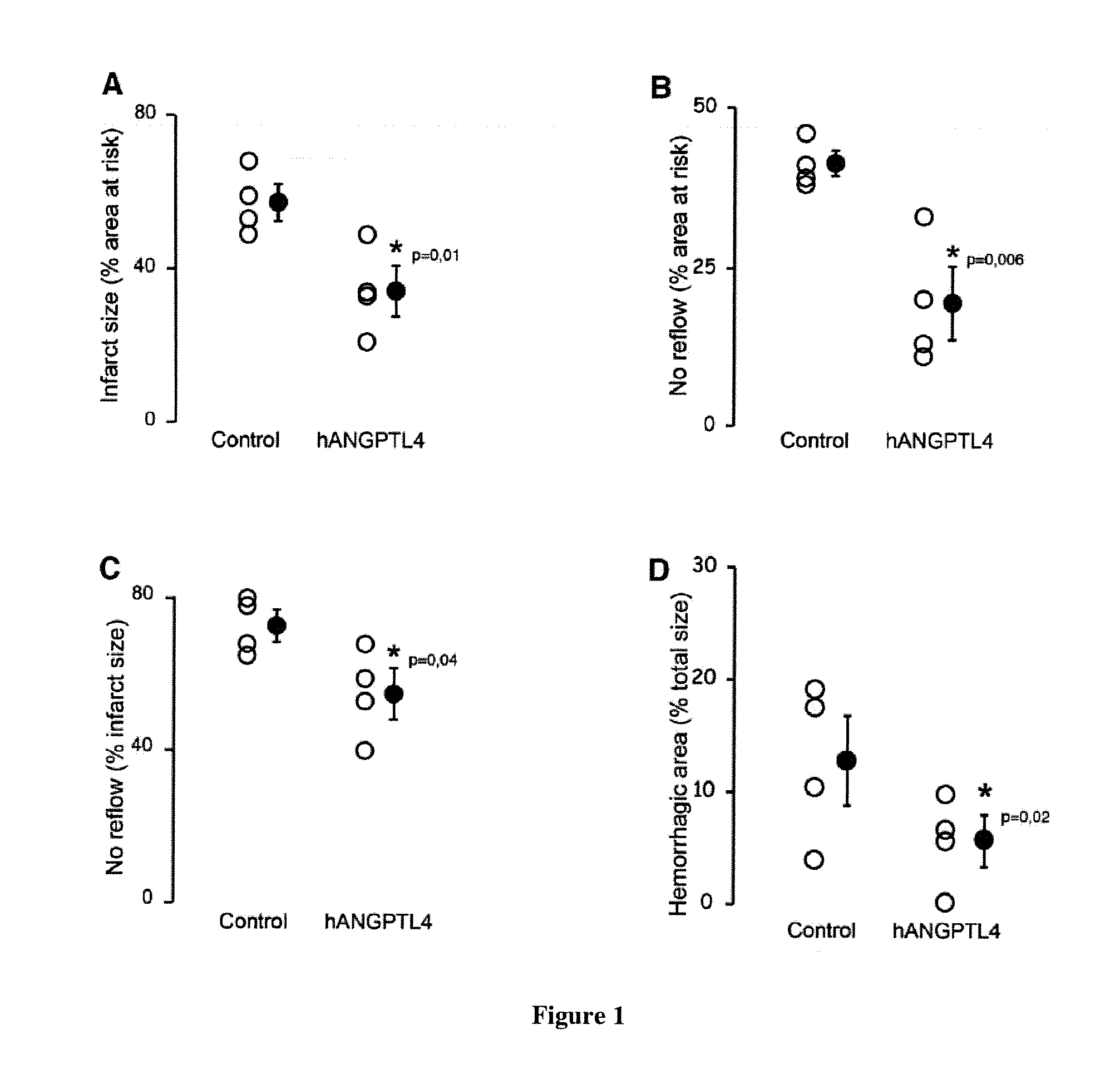Methods and Pharmaceutical Composition for the Preservation of Vascular Endothelial Cell Barrier Integrity
a technology of endothelial cell and vascular endothelial cell, which is applied in the field of angptl4 polypeptide, can solve the problems of inability affecting the survival rate of patients, so as to achieve the effect of reducing the no-reflow phenomenon
- Summary
- Abstract
- Description
- Claims
- Application Information
AI Technical Summary
Benefits of technology
Problems solved by technology
Method used
Image
Examples
example 1
Cardioprotection Through Preservation of Vascular Endothelial Cell Barrier Integrity by Angiopoietin-Like 4
[0089]Material & Methods:
[0090]The experiments were performed in accordance with the official regulations edited by the French Ministry of Agriculture. This study conforms to the standards of INSERM (the French National Institute of Health) regarding the care and use of laboratory animals, was performed in accordance with European Union Council Directives (86 / 609 / EEC).
[0091]Animals and Genotyping:
[0092]Genotype was determined by PCR of tail genomic DNA using the following conditions: denaturation at 94° C. for 30 seconds, annealing at 56° C. for 45 seconds, and extension at 72° C. for 1 minute and 15 seconds, 30 cycles. Wild-type (angptl4+ / +), angptl4LacZ / + and angptl4LacZ / LacZ knock-out C57BL / 6 mice, 8 to 12 weeks of age, were subjected to myocardial infarction protocols or used as control in basal conditions.
[0093]Myocardial Ischemia-Reperfusion Experiments:
[0094]Male angptl4...
example 2
Protection Against Myocardial Infarction and No-Reflow Through Preservation of Vascular Integrity by Angiopoietin-Like 4
[0136]Material and Methods
[0137]The experiments were performed in accordance with the official regulations edicted by the French Ministry of Agriculture. This study conforms to the standards of INSERM (the French National Institute of Health) in accordance with European Union Council Directives (86 / 609 / EEC).
[0138]Myocardial Ischemia-Reperfusion Experiments:
[0139]Ischemia-reperfusion protocol was performed on angptl4LacZ / + and angptl4LacZ / LacZ mice or rabbits using a standard technique described in Supplemental Materials. Rabbits randomly received either vehicle or human recombinant 55 kDa full-length ANGPTL4 (rhANGPTL4 10 μg / kg i.v.).
[0140]Modified Miles Assay:
[0141]Male angptl4LacZ / LacZ and angptl4LacZ / + mice were anesthetized using pentobarbital. For basal conditions, mice were injected into the tail vein with 1% Evans blue (200 μl) and sacrificed 4 h later. For ...
PUM
| Property | Measurement | Unit |
|---|---|---|
| molecular weight | aaaaa | aaaaa |
| pressure | aaaaa | aaaaa |
| thickness | aaaaa | aaaaa |
Abstract
Description
Claims
Application Information
 Login to View More
Login to View More - R&D
- Intellectual Property
- Life Sciences
- Materials
- Tech Scout
- Unparalleled Data Quality
- Higher Quality Content
- 60% Fewer Hallucinations
Browse by: Latest US Patents, China's latest patents, Technical Efficacy Thesaurus, Application Domain, Technology Topic, Popular Technical Reports.
© 2025 PatSnap. All rights reserved.Legal|Privacy policy|Modern Slavery Act Transparency Statement|Sitemap|About US| Contact US: help@patsnap.com

